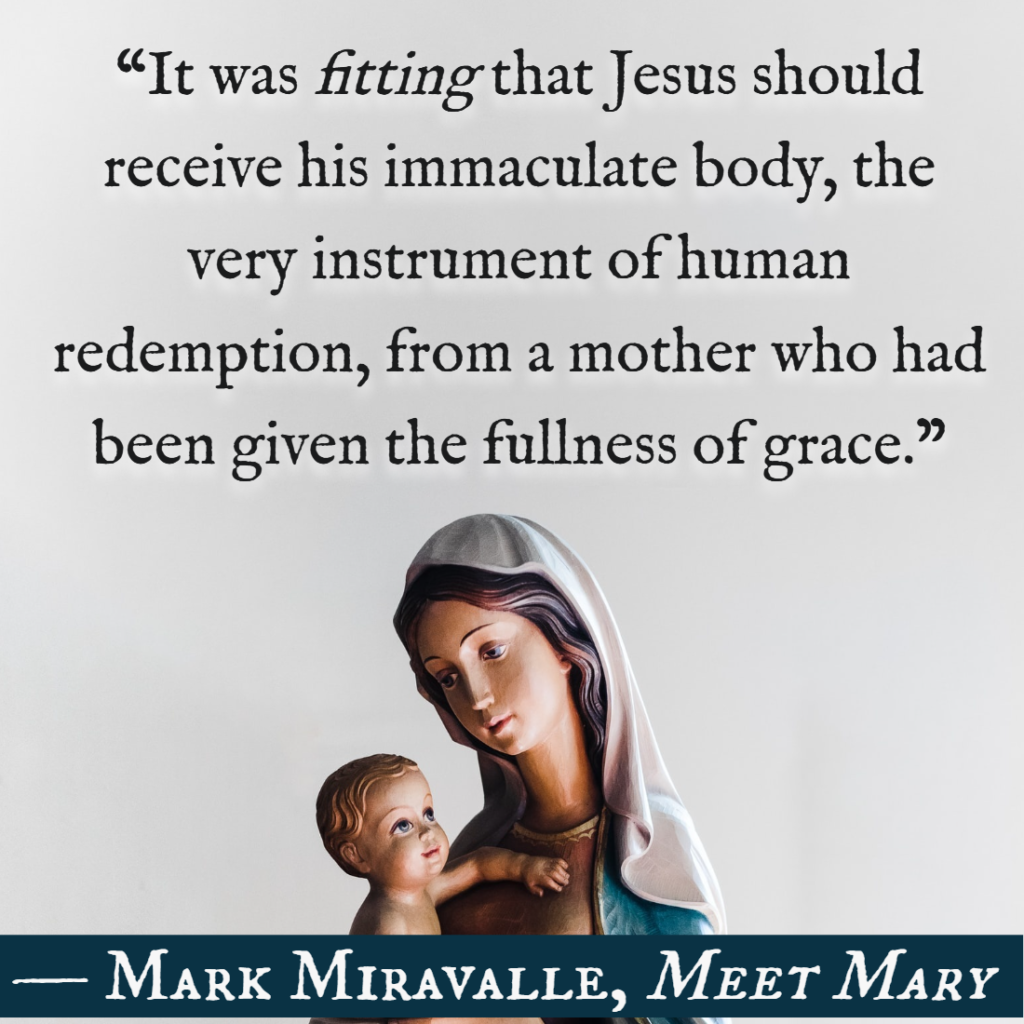The Immaculate Conception is not the virgin birth. I want to make that really clear at the beginning, since far too many people get hopelessly confused on that point. Furthermore, the conception that was “immaculate” was Mary’s, not Christ’s.
The dogma of the Immaculate Conception says that at the very moment of Mary’s conception, both her soul and her body were created without the stain of Original Sin; they were immaculate. The dogma of the Immaculate Conception does not say that Jesus’ conception was “immaculate” because it didn’t involve sex (all of us who were conceived in the ordinary way are not “stained” thereby, because, if you remember, sex is a good thing created by God).
Original Sin
When Catholics talk about Original Sin, we’re referring to the inherited wound all men and women have in their souls. That wound was inflicted by the sin of our first parents (Adam and Eve), has been passed on since that Fall, and will continue to be passed on until the end of time. The effects of the wound are known all too well. We don’t even have to look around at all of the evil and hatred in the world to see them. All we have to do is look inside ourselves to know what Original Sin has done to human nature.
Although referring to the “stain” of Original Sin is a pretty common metaphor, it’s not quite accurate. Original Sin isn’t something that was added to the human soul, the way a stain mars clean clothing. It’s more like something that was taken away, something now lacking in the soul: namely, the grace that God originally intended us to have within us. That grace was to be the spiritual sustenance for our earthly life, our heavenly life, and for our relationship with God in both lives. When Adam sinned, however, that grace was lost, and man no longer had enough sustenance to live as he was supposed to live.

Catholics believe that when Christ died on the Cross, he made it possible for men and women once more to have access to spiritual life, to the grace we so desperately need. We also believe that we receive that heavenly help when we profess our faith in Christ and are born into new life through Baptism, and, by that help, we can have our souls healed, growing in grace and sanctity in this life until we are fully transformed by it in the next.
Mary’s Grace-Filled Nature
Thanks to her Immaculate Conception, Mary never suffered the deprivation of grace to begin with. She was full up from the start. That fullness of grace enabled her to choose the good and the right every day of her life. Like our first parents, who also were created with a certain fullness of grace, she could have sinned. But she didn’t. Not once. In any way.
Now, Mary’s sinless nature was not something she earned on her own or even merited. It was a grace, and like all grace, it was a pure gift from God. And even though it occurred in time prior to her son’s redemption of the world on the Cross, that grace flowed from the Cross all the same. God, because he’s God and outside of time and can do things like that, applied the merits Jesus earned on Calvary to Mary at the first instant of her existence. That means Mary owes her salvation to God as much as any of us — or rather, more so, since she was redeemed from more: not only saved from sin but completely untouched by it.
The seeds of this teaching are found in both the Old and the New Testaments. In Genesis 3:15, after Adam and Eve have lost the fullness of grace, God addresses Satan, represented by the serpent, and says, “I will put enmity between you and the woman and between your seed and her seed; she will crush your head, and you shall lie in wait for her heel.” As we said earlier, Jesus is the seed that is victorious over the evil seed of Satan. That means the woman God refers to is Mary, the mother of Jesus — not Eve, the mother of a grand bunch of sinners.
Importantly, the word enmity does not mean mere “dislike” or “mild distaste for,” but rather “complete and total opposition.” (Other places where the Hebrew word for enmity is used in the Old Testament refer to scenes of violent opposition, and even to struggles unto death.) Now, in theory, I am in complete and total opposition to sin. I think it’s a very bad thing, and I try not to do it. Try is the operative word there, for as much as I dislike it, I still sin. This means that I’m really not in state of complete and total opposition to sin. Enmity does not exist, in the truest and fullest sense of the word, between Satan and me.
Now, had Mary sinned in any way at any point, she, too, would have been in at least partial participation with Satan. But that would directly contradict what God tells us in Genesis 3:15.
In the New Testament, we also see the origins of this teaching when Gabriel appears to Mary.48 When he greets her, he says, “Hail, full of grace.” Not, “Hail Mary,” but “Hail, full of grace.” “Full of grace” is what he calls her. He refers to her by it as by a name. The Greek term for “full of grace” is kecharitomene, a big word with a complex meaning even for those who know biblical Greek, for it refers to a sanctifying action that was accomplished in the past-perfect tense. That’s why the angel’s greeting can be best translated, “Hail, you who have been perfected in grace.”
Remember, perfection in grace is just what the rest of us are lacking. Those of us who have accepted Christ and received the gift of baptism receive great graces, as well as the capacity to receive more graces, but we know through simple experience that we’re not perfected in grace. But Mary did have the fullness of grace: she is what God originally intended all of us to be. And the angel’s greeting to her tells us that she had been granted that fullness at some point in the past: at, we believe most logically, the very instant of her conception.
The Church Fathers
The early Church Fathers also compared Mary’s sinless state to Eve’s sinless state before her fall. Mary, as the “New Eve,” was believed to have enjoyed the same state of original grace and justice that Eve was granted in the Garden. Since Eve was obviously created in a state of grace, without the fallen nature the rest of us have inherited from her and Adam, the parallel made between Eve and Mary by the Church Fathers likewise illustrates their understanding of Mary’s immaculate creation.
In the words of St. Ephraem, “Those two innocent. . . women, Mary and Eve, had been [created] utterly equal, but afterward one became the cause of our death, the other the cause of our life.”
St. Ephraem also alluded to Mary’s sinless nature when, addressing Jesus, he wrote, “You and your mother are the only ones who are immune from all stain; for there is no spot in Thee, O Lord, not any taint in your mother.”
In time, references to Mary’s Immaculate Conception became more and more explicit and developed. St. Ambrose of Milan referred to Mary as “free from all stain of sin.” St. Severus, Bishop of Antioch (d. 538) stated that Mary “formed part of the human race, and was of the same essence as we, although she was pure from all taint and immaculate.” St. Sophronius, Patriarch of Jerusalem (d. 638) signaled that Mary’s purification indeed occurred from the first moment of her existence when he wrote, “You [Mary] have found the grace which no one has received. . . No one has been pre-purified except for you.”
Such testimonies (and there are many others) from the early Church Fathers are particularly important, because they lay to rest another common misconception about the dogma of the Immaculate Conception: namely, that Pope Pius IX made it up, pulled it out of thin air, when he proclaimed it an official Catholic dogma in 1854. As we saw earlier, before being officially proclaimed by the Church, dogmas have to be solidly rooted in the ancient teaching of Jesus and the Church. That’s what gives them authority.
The Immaculate Conception of the Blessed Virgin Mary
In the end, though, it really shouldn’t be all that hard to believe in Mary’s Immaculate Conception. After all, God originally intended for all of us to be immaculately conceived. His first plan was that every man and every woman would begin their life in the family of God. Only because of the Fall are we now conceived without that fullness of grace. Mary is for us the shining exception, but she ought to have been the norm.
Nonetheless, her preservation from sin was a singular privilege. This free gift from God to Mary prepared her to be the perfect mother of God made man. And it was supremely appropriate (although not absolutely necessary), that Mary should pass on to Jesus, the spotless lamb without sin, a human nature identical to her own, just as our mothers passed on to us natures identical to their own. The difference being, of course, that Mary’s nature should also be, and was, immaculate.
Think of the opposite possibility. Imagine that God the Son had to come into direct contact with Original Sin in becoming man because his mother, in her body and soul, was contaminated with the victory of Satan, his chief adversary. Did God not empty himself enough by taking on our limited human natures without having to have his flesh given to him by one directly wounded by his ancient foe?
No, it was right that the one who came to redeem humanity from sin should receive his own human body from a woman who benefitted chiefly and preemptively from his eventual victory over sin. It was fitting that Jesus should receive his immaculate body, the very instrument of human redemption, from a mother who had been given the fullness of grace.
✠
Editor’s note: This article is adapted from a chapter in Dr. Miravalle’s Meet Mary: Getting to Know the Mother of God. It is available from your favorite bookseller or online through Sophia Institute Press.
image: Shrine to the Immaculata in the Basilica of Our Lady of Victories, Lackawanna, NY / photo by Fr. Lawrence Lew, O.P. / Flickr (CC BY-NC-ND 2.0)













